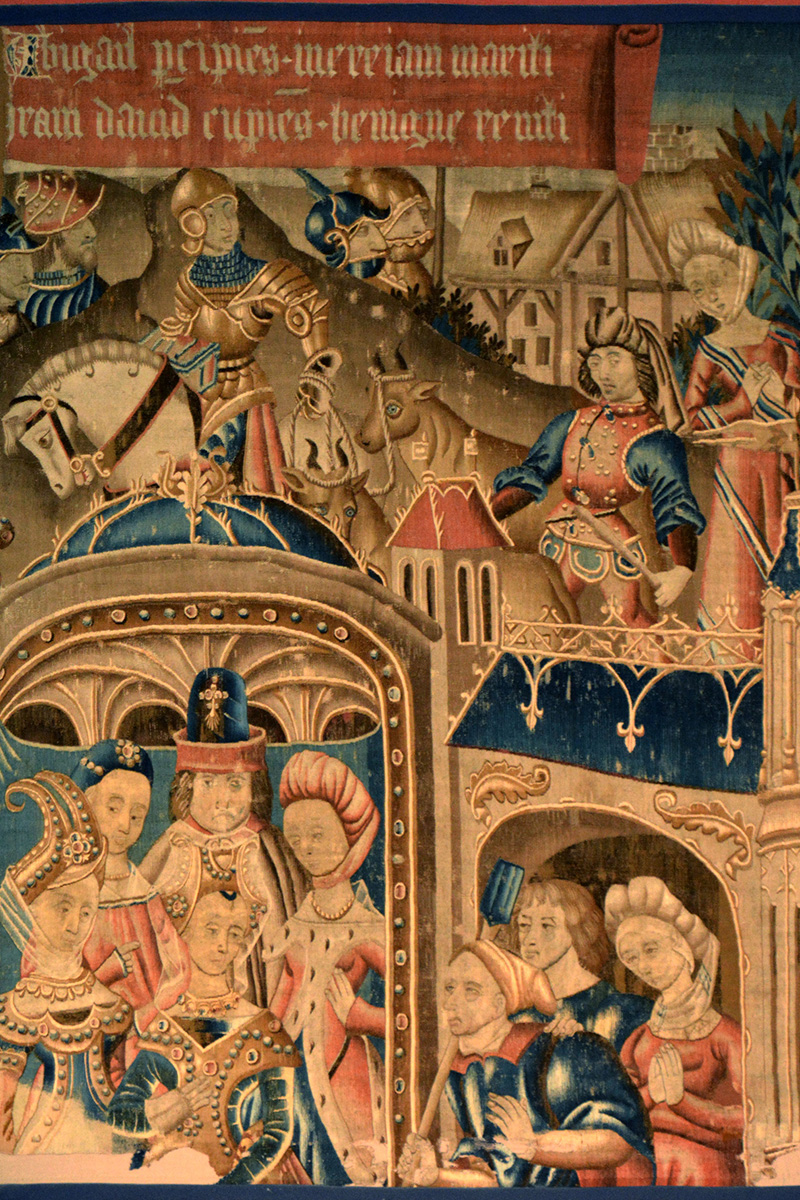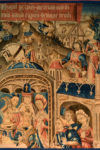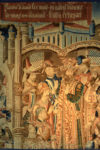
David and Abigail Tapestries [TA3a-b]
Tournai, Southern Netherlands, c.1475
Two fragments from a single tapestry, wool (each approx. H. 270cm, W. 210cm)
The two tapestries above the fireplace in School show episodes from the Old Testament story of David, Nabal and Abigail. They are fragments of a single tapestry that was originally much larger.
The scenes depicted are taken from I Samuel 25. Having fled from King Saul, David lived for a time with his followers in the wilderness of Judea. In need of supplies, he sent some of his servants to Nabal, a wealthy landowner, expecting him to receive them generously. Foolishly, Nabal refused their request, asking ‘Who is David?’ When David heard about this insult, he gathered an army and planned his revenge. Having learned of her husband’s actions, Nabal’s wife Abigail gathered supplies and went to meet David. Intercepting him on his mission to destroy Nabal, she urged him to leave vengeance to the Lord. David relented and, when Abigail told him what had happened, Nabal was instantly struck dead. Soon afterwards, David married Abigail.
The left-hand panel shows Nabal refusing to help David. He stands in the centre of the composition, with his hands raised in a dismissive gesture. David’s servants are on the left, dressed in contemporary Northern European fashion. Nabal’s men are on the right, wearing exotic clothing. The right-hand panel shows Abigail in a palatial interior attended by her ladies-in-waiting. On the right, a group of servants arrive with news of her husband’s treatment of David. In the scene above, Abigail has gone out to meet David’s soldiers on their way to attack Nabal.
Both tapestries feature a banderole at the top with Latin verses explaining the action. The tapestry on the left (Nabal’s Refusal) reads: ‘David’s anger was deep. He will have revenge on Nabal / He sends an army to destroy this fool.’ On the right (Abigail’s Appeasement) the verses read: ‘Abigail takes action to correct her husband’s error / David quell your anger. Kindly resist.’
The style of these tapestries indicates that they were made in the Flemish city of Tournai in the late 15th century. Tournai was then a French enclave surrounded by Burgundian territory in the Southern Netherlands (modern-day Belgium). Along with other nearby cities – Brussels, Arras and Lille – it was one of the main centres of tapestry production in this period, its workshops receiving orders from across Western Europe.
Medieval tapestries were woven by hand on a loom using dyed woollen thread. They were labour intensive and very expensive. A skilled weaver took at least a month to complete one square yard of tapestry (the two fragments in School together make up 14 square yards). Weavers did not design tapestries themselves but followed a painted design known as a ‘cartoon’. In the Walters Art Museum, Baltimore, is another tapestry based on the same cartoon as the fragments at Winchester. It would have been common practice for workshops to reuse cartoons in this way, but the survival of two tapestries made from the same cartoon is very unusual. Tapestries are particularly susceptible to damage from damp, insects and sunlight, and to destruction through fire and changes in fashion. It seems likely that rather less than one percent of all fifteenth-century tapestries are still in existence.
The Walters Museum version is more complete than the tapestries at Winchester, showing that our panels are missing the lower third of each scene. There is also one additional episode of the narrative in the Walters version, which shows, to the left of Nabal’s Refusal, the return of David’s servants to the palace after Nabal’s death and David’s proposal of marriage to Abigail. Differences between the two versions are to be found in the inscriptions in the banderoles, which are in Latin on the Winchester tapestries, and in French on Walters tapestry. There are occasional differences in the colour of the figures’ clothing. More significantly, one of the Winchester panels includes a small section of a scene not present in the Walters version: to the left of Nabal’s Refusal is shown not the return of David’s servants and the proposal to Abigail (as in the Walters tapestry), but fragmentary figures corresponding to some other episode, perhaps the Death of Nabal.
It is not certain how these fragments came into the College’s possession. In 1575 six tapestries were purchased by the College for the Chamber used by the Warden of New College on his regular visits to Winchester. An inventory made in 1582 lists ten pieces of tapestry in this room and early seventeenth-century inventories indicate that these included the David and Abigail tapestries, along with the Tudor Rose tapestries now in New Hall. In 1619, an inventory recorded ‘2 old peeces of Arras concerning the history of David’ in the Warden of New College’s Chamber. They were in the same room in 1637, one being used as a carpet. Between 1685 and 1766 the tapestries were kept in the Bursary, then in Exchequer Tower at the west end of College Hall. By 1846 they were in Audit Room, also in Exchequer Tower. They appear in an illustration of the room published in Charles Radclyffe’s Memorials of Winchester College (1846). In 1903, the tapestries were cleaned and repaired. They were hung briefly in Musa and then Chapel before being moved to School in 1912.
Exhibited: Tournai, ‘Le tapisserie tournaisienne aux xve siècle’, 13 October – 20 November 1967
Literature: A. Kendrick, ‘Tapestry at Winchester College’, The Burlington Magazine, Vol. 6 (1904-05), pp. 490-95; H. Chitty, The Winchester College Tapestries (Winchester, 1912); W.G. Thompson, A History of Tapestry (London, 1930), pp. 153-54; J.P. Asselberghs, Le tapisserie tournaisienne aux xve siècle (Tournai, 1967), pp. 2, 11-12, 30, plates 17-18; Adolfo Salvatore Cavallo, Medieval Tapestries in the Metropolitan Museum of Art (New York, 1993), p. 220; R. Foster, Winchester College Treasury; a guide to the collections (Winchester, 2016), p. 9.
Provenance: Uncertain, but probably acquired by the College in the late 16th century (see notes above)
Location: School

